

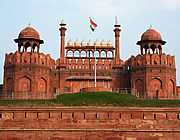
In February 2009 we travelled to India and saw so much that the account for this holiday is split into several articles.
This is the first part covering Delhi, Agra and Fatehpur Sikri, from centuries old bazaars to colonial New Delhi and the magnificent Taj Mahal.
As the Mughals feature strongly in the places we visited, a liitle history might be helpful:
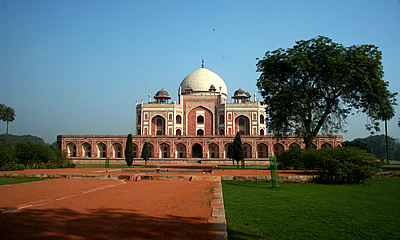
Babur: the first Mughal Emperor and great-great-great-grandson of Tamerlane (Timur the Lame), the notoriously brutal Monghul who sacked Delhi in 1398, slaughtering the inhabitants and plundering its wealth. Babur defeated Ibrahim Lodi in the first battle of Panipat, 1526. Succeeded by his son Humayun.
Humayun: there was a short hiatus in Mughal rule when Humayun was defeated by Sher Shah Suri in the battle of Kanauj, 1540; Humayun reclaimed Delhi in 1554.
Akbar: after the accidental death of Humayun he was succeeded by his thirteen year old son, Akbar, who was to become the greatest of all Mughal Emperors, ruling for 49 years from 1556 to 1605. He re-established the Mughal Empire in 1568 and was a religiously tolerant ruler, marrying a Rajput princess and banning sati - the ritual suicide of widows.
Jahangir: ruled from 1605-1627, strongly influenced by his Persian wife Nur Jahan. Succeeded on his death by his son Khurram who took the title Shah Jahan: Monarch of the World.
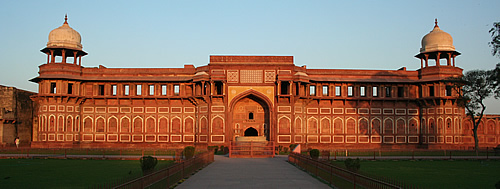
Shah Jahan: 1627 - 1658, the pinnacle of the Mughal Empire; he was a great patron of the arts, builder of the Taj Mahal for his adored wife Mumtaz.
Aurangzeb: an Islamic hardliner he deposed his father during illness and imprisoned him in Agra Fort where he died; Aurangzeb's intolerance led to war with the Rajputs and destabilisation of the empire followed by its gradual collapse on his death in 1707.
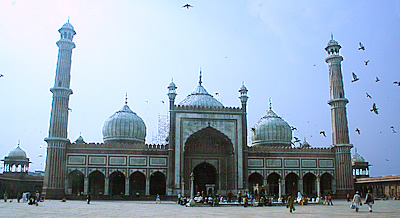
This was our first visit to India and we had heard all the dire warnings about poverty and begging, the crowded streets and terrifying roads. This is all true, but alngsie these we met wonderful people, always ready with a smile and curiosity in who we were.
Delhi is a centuries-old city, destroyed and rebuilt many times, witness to the rise and fall of mighty dynasties, whose people have endured much.
Jama Masjid is the largest mosque in India with a capacity of 25,000 people and regularly getting 10,000 for Friday prayers. It was built between 1644 and 1658 by Shah Jahan who reigned at the peak of Mughal power.
Shah Jahan was a patron of the arts and his reign produced some of the most notable examples of Mughal art and architecture, most especially the magnificent Taj Mahal.
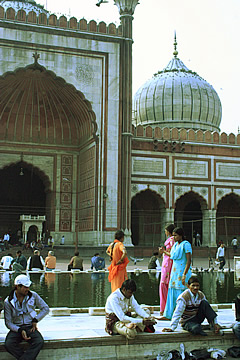
The mosque is approached by a high and wide flight of stone steps. As usual for holy places, shoes must be removed before entering the mosque.
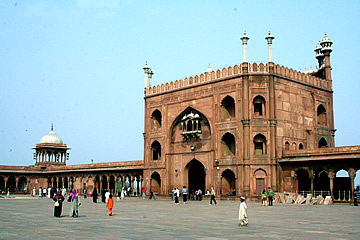
On the western side of the courtyard is the main prayer hall with three domes, a wide roofed space where prayers are offered, the mihrab marking the direction of Mecca occupying a niche in the centre of the west wall.
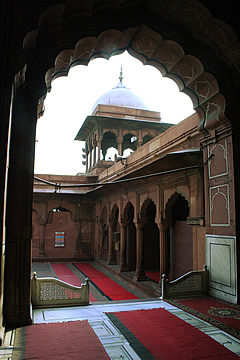
This is an open-air building with a large central pool in the courtyard for ablutions. Being open-air it lacks a central dome which usually forms an impressive feature of important mosques.
We found this mosque curiously uninspiring but when full it is probably very atmospheric. I have seen photographs of a full mosque and it looks incredibe.
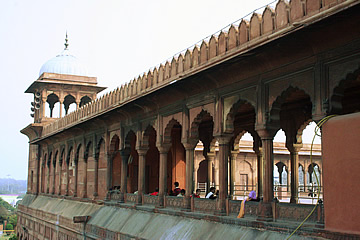
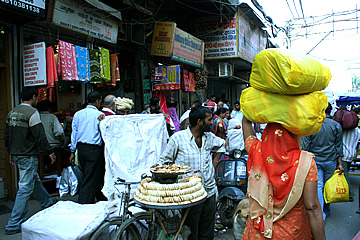
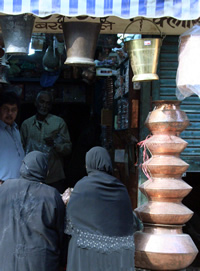
We took a bicycle rickshaw through the very congested streets of Chandni Chowk and it was quite an experience! At a standstill a great deal of the time because of the sheer volume of traffic on the road, we passed through the bazaars devoted to paper, printing and books.
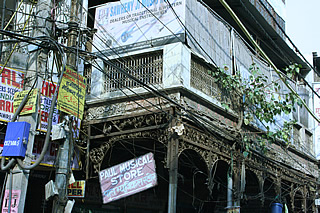
Enormous bundles of electric cables are strung haphazardly over the streets where remnants of once-fine buildings can be seen.
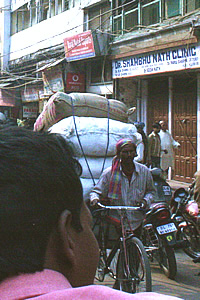
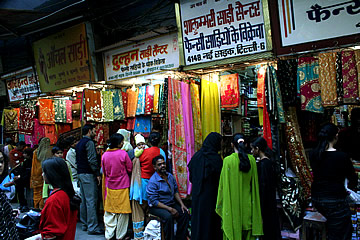
The road was jammed with all manner of vehicles, mostly bicycles and bicycle rickshaws, tuk-tuks and motorbikes. Lots of men making deliveries or collecting goods, selling food from large trays or stalls, or just squatting talking and drinking chai. When our driver did get up any speed it was a matter of hanging on very tightly!
At one time Chandni Chowk was the street for high class homes of Mughal Delhi with a tree-lined canal down its centre. The Mughals, a Turkish-Mongolian fusion, invaded in 1526 and ruled until the sacking of Delhi by Persian invaders in 1739.

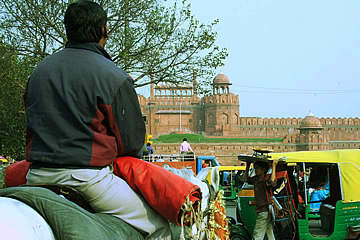
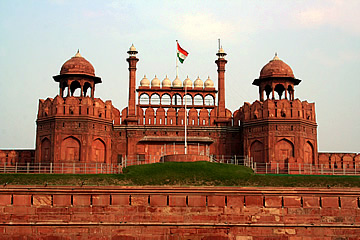
Shahjahanabad was the seventh incarnation of the city, built by Shah Jahan in 1638. At its north eastern corner lies the imposing red sandstone fort. Originally the Yamuna River flowed to the east of the fort but the course of the river has changed over the years and it now lies much further away. Though the wide moat is dry, the fabulous colour, height and extent of the walls combine to make an extremely impressive exterior above which towers the magnificent Lahore Gate. Gates in Rajasthani forts are often named for the city which they face.
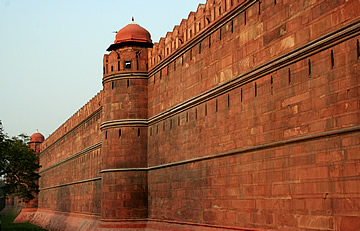
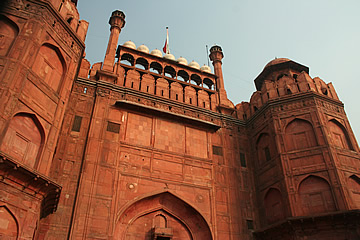
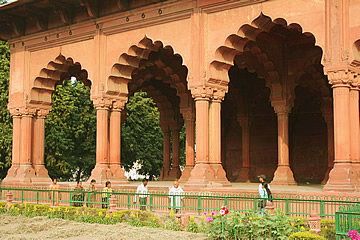
Security when we visited was quite tight, with scanners - separate lines for women and men, naturally the queue for the ladies was longer! Through security and into a covered arcade, Chatta Chowk, now full of tourist-tempting merchandise but originally for the ladies of the palace.
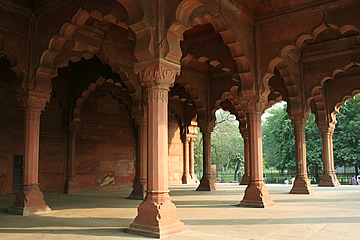
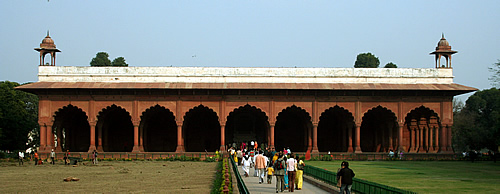
The Diwan-i-Am or Hall of Public Audience, also built in red sandstone, is a pillared and arched hall where the people could air their complaints to the emperor. Lord Curzon, Viceroy of India between 1898 and 1905, restored this hall and had the Imperial Throne returned from the British Museum in 1909.
Traditional Indian architecture would incorporate neither an arch nor a dome - both these elements are borrowed from the Islamic tradition. Indian buildings would invariably add embellishments to these elements, as here in the scallop arches.

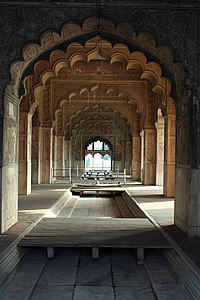
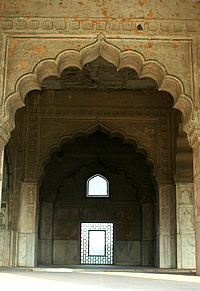
Further on, a wide grassy space leads to an array of beautiful white buildings.
Southernmost is the Rang Mahal (Palace of Colour) for the Emperor's wives and mistresses, once beautifully decorated. Then north is the Khas Mahal (the Emperor's private palace) and the Diwan-i-Khas (the Hall of Private Audience).
The Rang Mahal was the palace for the royal ladies. Originally lavishly decorated it still retains a beautiful marble lotus fountain from which water channels carried the "River of Paradise".
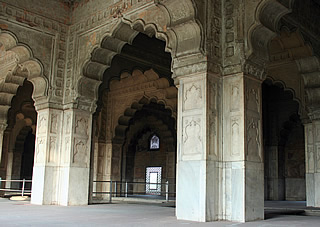

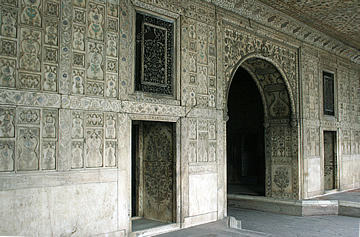
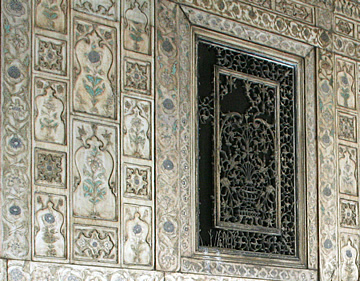
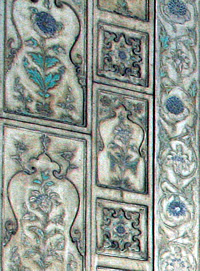
The Khas Mahal was the emperor's private residence. Again carved from beautiful white marble it also had colourful decorations
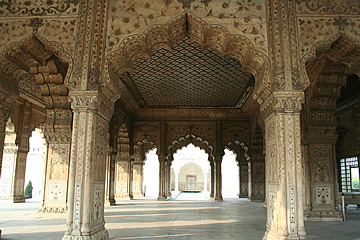
The Diwan-i-Khas is the most beautiful building in the complex. Here the Emperor would have received only the most important visitors in seclusion.
Its marble pillars are decorated with lovely carvings and inlaid "petra dura" flowers.
Buildings built without continuous walls and open to the elements would have been hung with light draperies in summer and heavier materials in winter.
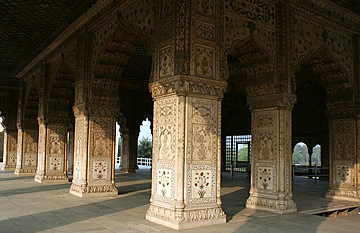
A fabulous Peacock Throne originally stood here, inlaid with precious stones, but it was looted by the Persian Nadir Shah in 1739.
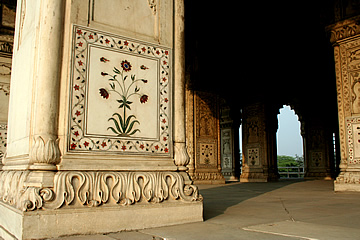
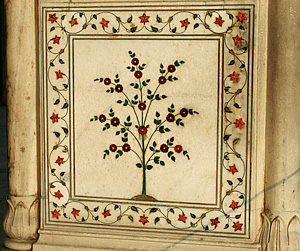
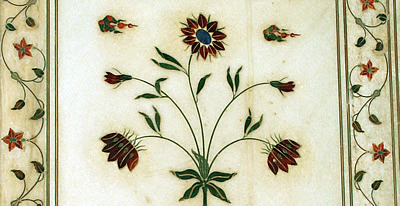
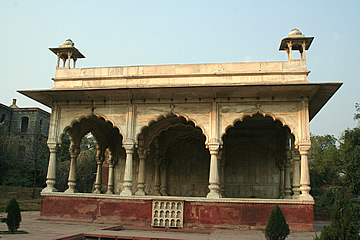
North again are the hamams, the Royal Baths. Closed when we were there it was possible to peek inside to see more lovely marble inlay.
West of the hammams is the small marble Moti Masjid (Pearl Mosque), built by Aurangzeb, the son of Shah Jahan. Perfectly aligned with the other buildings of the fort, the interior walls are skewed to align with the direction of Mecca.
Further away, to the north west of these buildings, stand two monsoon pavilions separated by a large pool where the Emperor could watch the monsoon rains. He could even go boating on the pool if he wished. What an image that conjures - the teeming rain beating into the pool between the two pavilions and the Emperor in his splendour enjoying the show!
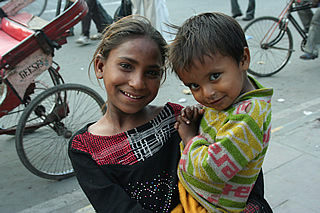
Outside the fort a young girl with a boy carried on her hip grinned at our guide and started an animated conversation. He explained that she was eight years old and was often outside the fort and that, though she was looking after her young brother (they very clearly doted on each other), her parents were nearby. She sometimes sold postcards or other things to tourists or just asked for money. She did not beg anything from us but was obviously curious and eventually asked if I would take her photograph with her brother. This I did and she was delighted - I think this was one of the best photographs I took in India. Such a happy child, old beyond her years, but doing what she could to help her family and seemingly not envious of the fortune of others, just getting on with life.

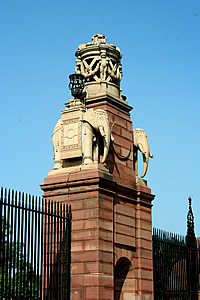
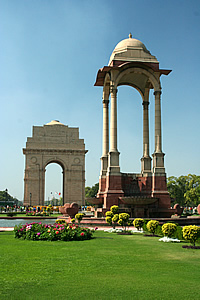
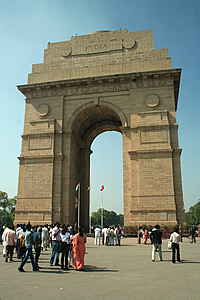
Delhi was made the new capital of India by George V in 1911, replacing Calcutta, and Edwin Lutyens was commissioned to design the new government area. Even our guide described Lutyens' New Delhi as the most beautiful part of the city.
A long and wide boulevard, the Rajpath, is flanked by green lawns, fountains and majestic trees - it could almost be the Mall in London. It has perfectly symmetrical classical buildings at the west end and the India Gate at the east. On the day we visited all the seating from the annual January 26th Republic Day parade was being dismantled from the Rajpath.
The India Gate, completed in 1921, is a Memorial Arch to the 90,000 Indian soldiers who died in the First World War and more than 3000 British and Indian soldiers who died on the North West Frontier or in the Afghan War of 1919. Sadly one cannot approach the arch to see the inscribed names. To the east of the India Gate is an empty canopied platform. Once this held a statue of King George V which is now banished to remote Coronation Park!
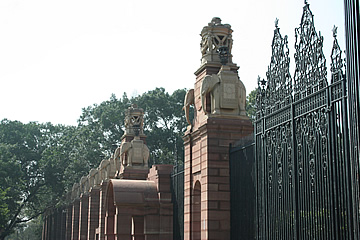
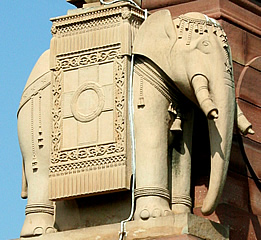
The presidential palace, larger than Versailles and flanked by ministry buildings, faces the length of the Rajpath and was the residence of the last Viceroy of India, Mountbatten. There is a Lutyens designed Mughal garden here, with quartered beds and water channels and fountains but it is only open to the public from mid-February to March.
I particularly liked the line of elephants on the walls either side of the main entrance gate. Apparently Lutyens wasn't too keen on Indian architecture and tried to keep its influence low.
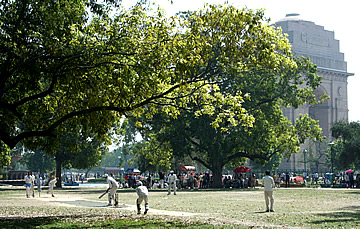
If there's one subject which almost all Indian males will gladly discuss it is cricket. Amazingly one of our guides in Rajasthan professed not to be interested in the game but everyone else had an opinion.
Everywhere you go children play it in the streets, in alleyways, on derelict ground, in the fields - anywhere with enough space to swing a bat which can be anything from a strip of raw wood to a proper cricket bat.
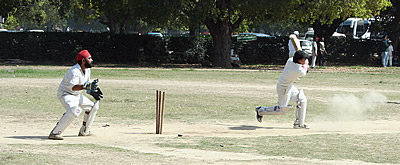
We were really lucky to be at the India Gate on a Sunday and were amazed to see dozens of games being played on the lawns beneath the trees.
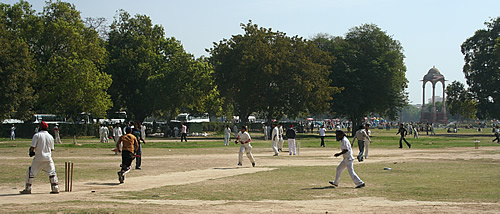
Outfields overlapped wildly but there was no mistaking the seriousness of the players. We were obviously something of a rarity as we circled the fields - some wanted to be photographed with us, all those we passed smiled and said hello - it was great!
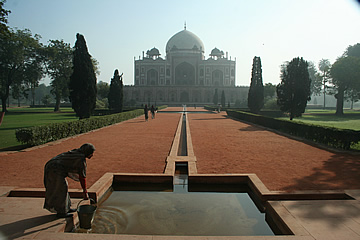
A wonderful building in a very peaceful setting, this mausoleum of the second Moghul emperor was begun in 1564 by his Persian senior wife Haji Begum. She also supervised its construction going so far as to camp outside until it was complete. Haji was the mother of Akbar - the famous third Emperor.
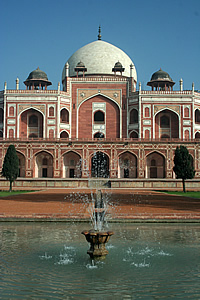
The red sandstone and white marble building housing the tomb is set in extensive Islamic gardens with fountains and water channels and it is easy to see that it might have been of some inspiration for the Taj Mahal.


It has a double dome - an inner and outer dome, the inner one forming the interior domed ceiling.
As well as Humayan and Haji Begum's tombs there are quite a few other tombs inside the building, but it is the exterior which is the main attraction. In the early morning, probably also in late evening, it is so beautiful and peaceful.
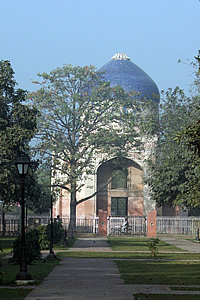
To the east of the tomb complex is the bright blue-domed Nila Gumbad (blue dome), which the Rough Guide says was probably built by a nobleman to honour a faithful servant.
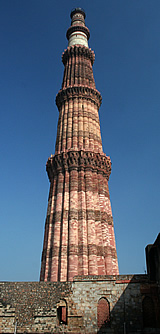
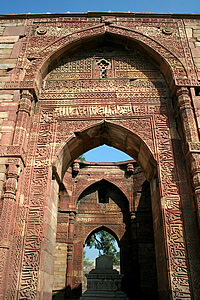
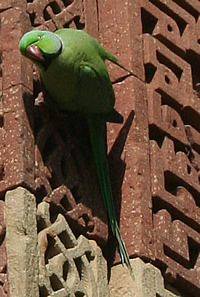
This impressive complex comprises the first monuments of Islamic India. These include the Qutb Minar itself, begun in 1199 by Qutb-ud-din Aibak, of Turkic origin, celebrating a victory which marked the beginnings of the Delhi Sultanate. Qutb-ud-din Aibak became the first sultan of Delhi.
Rising to over 72 m it has five distinct sections, the lower three of which are in red sandstone and deeply ribbed, the upper two in white. It looks a bit factory chimneyish but only because Victorian industrialists tried to beautify their factories by modelling chimneys on, for example, Italian campaniles, and they were invariably made of red brick! The tower tapers from a diameter of 14.32m at its base to 2.75m at the top.1
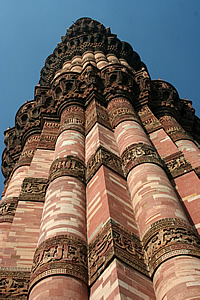
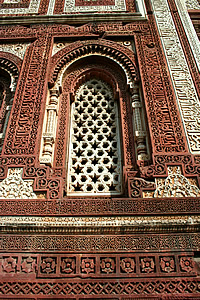
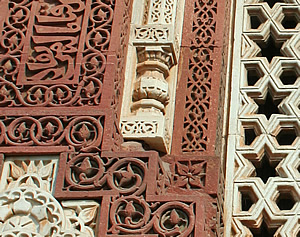
Qutb-ud-din Aibak was succeeded by his son-in-law, Shamsu'd-Din Iltutmish (AD 1211-36), whose mausoleum is here is beautifully carved with script and geometrical designs
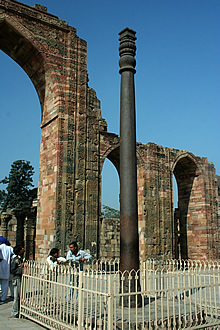
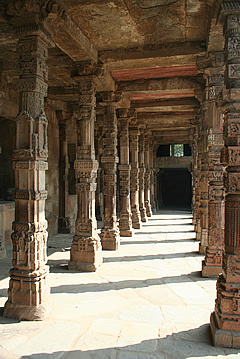
An amazing iron pillar stands in the courtyard. It is over 7m high and of almost 100% pure iron. It predates the mosque by many centuries and bears an insciption dedicating it to the memory of Chandragupta II who reigned from 375 to 413 AD. It is cast in a single piece which is incredible considering the time at which it was created.
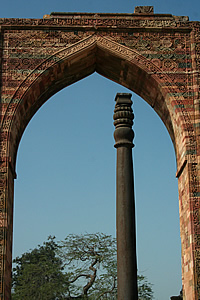
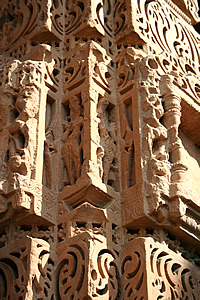
The ruined buildings surrounding the tower include the first mosque in India, built from the components of Hindu and Jain temples, with cloisters and a fine large courtyard, though all the faces of the carved figures have been obliterated in accordance with Muslim law and the columns in the cloisters have been reconstructed rather hapharzardly.
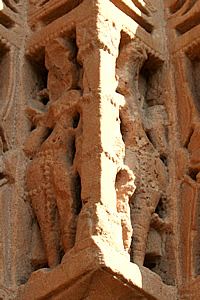
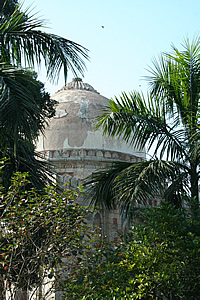
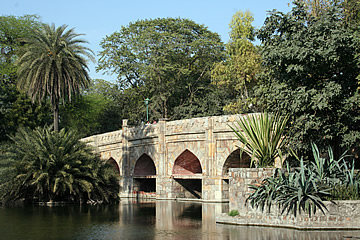
We approached the Lodi Gardens a couple of kilometres south west of the India Gate along Lodi Road.
On the north side of Lodi Road is the Khan Market which is a collection of shops rather than an actual market, some very cool and modern, lots of suiting/clothing shops where you can choose a cloth and have a garment made to measure.
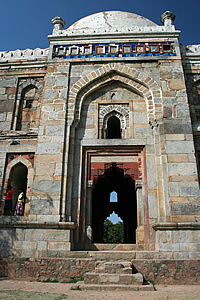
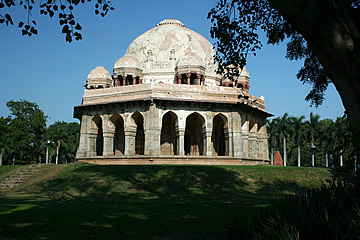
On the south side of Lodi Road is the Lodi estate of very fine houses. Most have a plaque on the wall next to the entrance gate naming the owner, and some have security posts. There were houses of a Vice Admiral, MP, ministers and a Rear Admiral where a wonderfully colourful wedding was taking place on the lawns, canopied tables loaded with food.
Lodi Gardens is a very restful place to spend a couple of hours, or even a whole afternoon. We saw lots of families here playing games or just relaxing on the grass with a picnic.
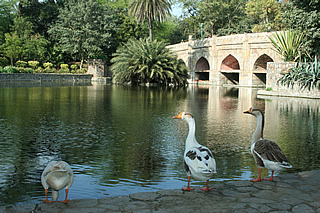
The gardens cover quite an extensive area with lawns, trees and flower beds plus quite a few impressive fifteenth and sixteenth century tombs of the Lodi and Sayyid dynasties. One particularly lovely octagonal tomb of Muhammad Shah (1434-1444) is surrounded by palm trees.
In Delhi we stayed at the Ahuja Residency which was our only disappointment in India. We had arrived at 3a.m., very tired, to be shown to a shabby (though very clean) room at the back on the ground floor (we were also woken very early by lots of noisy work going on immediately outside). Not happy about this we were too tired to do anything about it at the time, and there was only a caretaker there, so we slept and asked for a better room the next day. This we were given and it was OK for a couple of nights - modern furniture, nicely decorated with a very clean bathroom, but not very spacious. We couldn't really recommend this place to other visitors, though. Not sure why we stayed here - initially it was suggested by TransIndus and though we had the option to upgrade we didn't!